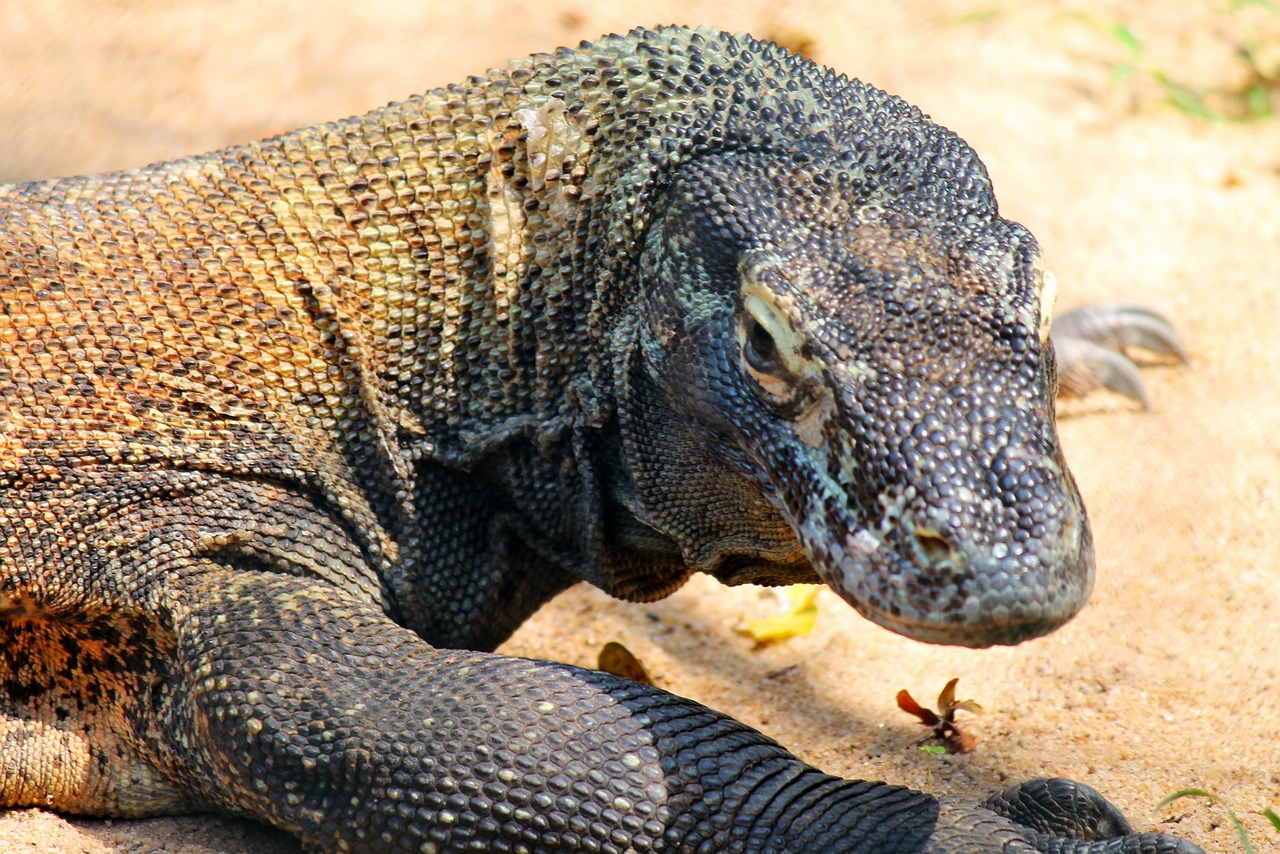Trivia about the Komodo dragon, the most powerful lizard Poison in its fangs, and death rolls
The Komodo dragon is the largest lizard currently on Earth. They can grow up to three metres in length and weigh up to 100 kilos in the largest individuals.
Despite their appearance, Komodo dragons are capable of considerable speed. They can reach speeds of around 20 km/h.
Their bite is also dangerous. It is not only painful. They contain a mixture of bacteria that can cause blood poisoning.

In addition to their toxic bite attacks, Komodo dragon hunting is a gruelling pursuit that involves wounding the prey and patiently chasing it for days until it succumbs. However, the basic style of hunting is ambush.
It has a unique method of shaking its prey to death as a technique. This is the so-called death roll. Crocodiles, as you may have heard, have the same technique.
Their skin is reinforced with small bones called osteoderms. This acts as a natural chainmail, preventing them from being bitten by other larger prey.
They are good swimmers and can travel between the Indonesian islands where they live.
However, populations are restricted to a handful of Indonesian islands, namely Komodo, Rinca, Flores and Gilimotan. They are of course endemic to these islands.
Komodo dragons have a very long lifespan for a reptile. Some individuals have been known to live for more than 30 years in the wild.
The lizards also have an extraordinary sense of smell. Humans inhale air through their noses and smell chemicals at the top of their noses, but they are slightly different. They use their forked tongues to pick up odour particles in the air and analyse them with specialised organs in their mouths.
They also play an important role in the ecosystem by controlling the populations of deer and other prey animals.
Females have the ability to reproduce monogenically. Monogamy is a form of asexual reproduction in which the mother can leave viable offspring without the need for a male. It is not commonly found in reptiles.
They have a complex social life, with hierarchies established by fierce wrestling matches between males.
Of course, being lizards, they are also excellent climbers. They use their powerful claws to climb trees with ease, especially when they are young and light in weight. And young Komodo dragons use this tree-climbing skill to avoid cannibalism.
Komodo dragons are carnivores and are known to eat a variety of prey, including invertebrates, birds and mammals. They can eat deer, pigs and even buffalo. Like condors and hyenas, they also consume carrion and other meat.
Remarkable digestive capacity. They can eat up to 80% of their body weight in a single meal, taking advantage of their flexible jaws to swallow large chunks of food.
Komodo dragons sleep in burrows. These burrows protect them from temperature extremes and predators when they are young. Their burrows are cool and spacious. Adult Komodo dragons can also sleep in dense vegetation or even in caves to find shade during the hottest part of the day and to stay warm during the night.
They may be commonly pictured in scenes of them lazing in the sun and being photographed. But they only employ ambush tactics to catch unprotected prey. When they move, they are fast.
Older adult Komodo dragons prey on smaller, i.e. younger, Komodo dragons. They are known to engage in cannibalism.
On the other hand, young Komodo dragons on their part have a rather unusual survival strategy to avoid cannibalism by their elders. They cover their bodies with faeces. In doing so, they avoid presenting themselves as a meal.
Komodo dragons are named after the island of Komodo, where they were first discovered.
They have powerful jaws and claws that are striking from the name ‘dragon’. But they also have a whip-like tail that can be used as a weapon. Be on your guard when approaching them.
Komodo dragons’ saliva is blood-red, often misleading people into thinking they have recently eaten their prey. However, it was originally that colour. Rest assured.
Do Komodo dragons attack people?
Such incidents are rare. However, they are certainly capable of potentially attacking humans. Encounters between Komodo dragons and humans that lead to attacks are rare to begin with. And in the event of an encounter, the Komodo dragon is surprised, not only by the human, but also by the Komodo dragon. However, be aware that during the mating season, when they are more aggressive, the risk of attack is higher than usual.
Anyway, visitors to Komodo Island are advised to maintain a safe distance and follow the guidelines provided by park rangers when in the vicinity of these creatures. Basically, they are gentle with humans as long as they are not provoked.
What is Komodo Island?
Komodo Island is part of the Sunda Archipelago in Indonesia. It is located on the island of Java, where the Indonesian capital, Jakarta, is located, and on the island of Bali, next to it, if you follow the island eastwards. It is located a little south of the equator.
It is world-famous for being the main habitat of the Komodo dragon. It is a volcanic archipelago with rugged terrain, arid savannah landscapes and monsoon forests. Although rich in nature, the island is a relatively desolate environment for this part of the world.
The climate of Komodo Island is tropical, with a distinct dry and rainy season. The dry season is from April to December and the rainy season is around January to March. The island is part of the Komodo National Park, a UNESCO World Heritage Site established to protect the Komodo dragon and its habitat. Despite the relatively harsh terrestrial environment, the island also supports a variety of wildlife, including not only Komodo dragons but also other reptiles, birds and mammals.
Komodo dragon aka Ora, land crocodile
The Komodo dragon (Varanus komodoensis) was named by Western scientists after it was discovered by Western countries in the early 20th century.
It was the Dutch colonial administrator Lieutenant van Steen van Hensbroek who first received reports of the animal and sent photographs and skin samples to Peter A. Uwens, director of the Zoological Museum in Bogor, Java. Museum director Uwens then published the first official description in 1912, naming the species the Komodo dragon.
However, that was in Europe. The locals call them “Ora” or “biawak raksasa” in Indonesian. They have their own name, given to them by the locals.
So Ora is not a Spanish greeting, but a local name for the Komodo dragon based on island mythology. The latter, “biawak raksasa”, is a more widely used name for a land crocodile.
The name Komodo Dragon is cool and I like it, but considering the death roll-using, hard-armoured, long-mouthed giant creature already mentioned, the locals’ name biawak raksasa, or land crocodile, seems more appropriate for them, as they have less biological features than Komodo Dragons. The name Biawak Laksasa, named by the locals, seems more appropriate for these creatures than Komodo dragons.



コメント